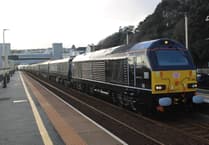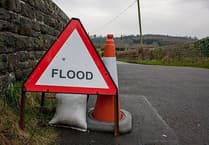TEN years ago Dawlish was in the eye of a devastating storm, the effects of which have changed the town’s seafront for ever.
Residents living along the line had to abandon their homes as the storm battered the sea wall, destroying a section completely and washing out the ballast beneath, leaving the railway track hanging in mid air.
Pictures of the destruction went around the world showing the force of nature.
But the night of February 4 and 5 2014 had long term consequences, cutting off the only rail link to the entire south west.
Eight weeks later, Network Rail had pulled off a mammoth feat of engineering by restoring the line.
Since then, a £165million package of resilience measures built by Network Rail and funded by the Department for Transport is proving to be effective at protecting the iconic stretch of track from rising sea levels and extreme weather.
After the storm, the South West Rail Resilience Programme was set up, following detailed studies to help determine how the railway between Dawlish and Teignmouth could better withstand such events.
Since 2019, the Programme has delivered:
A stronger, taller sea wall for Dawlish stretching for 800m between Boat Cove and Coastguard’s breakwater, with a new high-level promenade, link bridge and curved design to deflect waves back to the sea.
A new footbridge with lifts at Dawlish station, making it fully accessible for the first time in its history.
A 109m rockfall shelter at the northern end of Parson’s Tunnel, built from 185 pre-cast concrete units, coloured red to match the local sandstone, to protect the railway from the cliffs above.
The start of work to install 19,700 square metres of netting, secured by more than 6,000 soil nails, to improve cliff resilience between Dawlish and Holcombe. The project will continue until later this year.
In addition, £5m was allocated to develop plans for the railway between Parson’s Tunnel to Teignmouth, which has resulted in proposals to install cliff drainage and resilience measures, without moving the tracks away from the cliffs.
Network Rail’s capital delivery director Stuart Calvert said: ‘The South West Rail Resilience Programme is a really significant piece of work – not just for Network Rail but for the entire South West peninsula which relies on this vital artery to support communities, tourism and economic growth.
‘Since the unforgettable storm of 2014, this stretch of railway has undergone an incredible transformation which is testament to the hard work and dedication of our team of engineers and contractors BAM Nuttall and Morgan Sindall.
‘The new sea wall at Dawlish is performing as the design intended – returning the waves to the sea and allowing the railway to recover much more quickly from storms, while the rockfall shelter is preventing material from the cliffs reaching the tracks.
‘Our resilience work that is ongoing and that which is yet to come will better protect this key railway route from rising sea levels and extreme weather for generations to come.’
Rail Minister Huw Merriman said: ‘A decade ago, the Dawlish storm battered south Devon, devasting its coastline and severing the south west from the rest of the country for eight weeks.
‘Thanks to more than £165 million of Government funding to restore and protect this vital stretch of railway, its future is now secured. This will provide residents with peace of mind the line is better protected, no matter the weather.
‘The South West Rail Resilience Programme demonstrates we are delivering our promises to invest in vital infrastructure to futureproof the network and improve transport connections across the country.’
Anne Marie Morris, MP for Newton Abbot:, said: ‘Ten years since the storm that brought down the sea wall at Dawlish, and we have been on an incredible journey since then!
‘The South West Rail Resilience Programme is an incredible feat of engineering. Thank you to Network Rail, our very patient community and the many other unsung supporters of this vital project. We now just have the final phase to complete, which will be the most challenging part of the resilience programme - addressing the challenges of the cliffs at Teignmouth.
‘The Government has committed to deliver this fifth and final phase to ensure that the peninsulas most important line is truly resilient. I will be working with Network Rail to ensure that the Government keeps good on the commitment made 10 years ago.’




Comments
This article has no comments yet. Be the first to leave a comment.